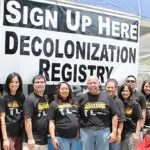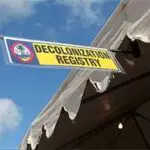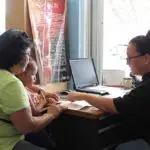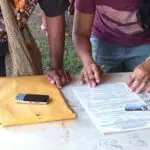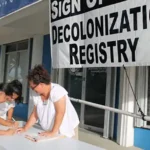CHamoru Registry and the Decolonization Registry
Table of Contents
Share This
In the early 1960s when the United Nations passed Resolution 1514 (XV) declaring that peoples in colonized territories had the right to self-determination, many non-self-governing territories around the world began to negotiate new political statuses and relationships with their colonial governments. The UN asserted that this movement toward self-determination should be a voluntary and democratic process, whereby the people of the territory choose their new relationship or status based on their needs and desires.
In the decades-long quest for change of Guam’s political status as an unincorporated territory and its relationship with the United States, the question has arisen, who is the “self” in self-determination? To answer this question, the Guam Legislature created a registry of eligible voters who would participate in any plebiscite that would be scheduled to change Guam’s political status. This registry is known as the Decolonization Registry.
However, the Decolonization Registry is often confused with the CHamoru Registry, also mandated by the Legislature. Both of these registries rely on similar definitions of “native inhabitant” stemming from the Organic Act of 1950, although each registry serves a different purpose and ultimately, is comprised of two different but overlapping sets of people. The CHamoru Registry is meant to record the progress of CHamoru people on Guam and around the world. With Guam’s multicultural-multiethnic population and history of immigration of various peoples into Guam and out-migration of CHamorus, determining the “self” in self-determination has been a divisive, sensitive issue, and of particular importance to those interested in participating in any process to change Guam’s political future.
The Guam Decolonization Registry
The Guam Decolonization Registry (GDR) plays a powerful role in actualizing Guam’s political destiny. Until there are enough native inhabitants registered on the GDR, a political status election cannot occur, according to Guam Law. However, since it was created, the Registry has not been prioritized enough by the Government of Guam to garner enough registrants, and has hindered the island’s progress toward self-determination.
According to the law, seventy percent of the island’s registered voters must be registered on the Guam Decolonization Registry before a political status plebiscite can occur. In order to choose a potential political status for Guam’s future, one must be a native inhabitant as defined by the law and must register on the Guam Decolonization Registry.
The GDR is legally defined by Public Law 25-106 as “an index of names established by the Guam Election Commission for the purposes of registering and recording the names of the native inhabitants of Guam eligible to vote in an election or plebiscite for self-determination.” The law defines native inhabitants as “those persons who became US citizens by virtue of the authority and enactment of the 1950 Organic Act of Guam and descendants of those persons.” A descendant is defined as, “a person who has proceeded by birth, such as a child or grandchild, to the remotest degree from any native inhabitant of Guam, and who is considered placed in a line of succession from such ancestor where such succession is by virtue of blood relations.”
Although the GDR was created by law in March of 2000, as of 2013 there are only 6,340 native inhabitants registered, as reported by 32nd Guam Legislature Speaker Judith Won Pat on 11 March 2013. This is not nearly enough registrants for a plebiscite to occur. There are several factors that contribute to this low number, but the most significant reasons are widespread misconceptions about the registry, and a lack of commitment from the Government of Guam to appropriately fund and support efforts to populate the registry.
History of the Guam Decolonization Registry
The last time the native inhabitants of Guam came close to voting in a political status plebiscite was in the year 2000. The plebiscite was scheduled to take place on 1 July 2000. However, that year was also a significant gubernatorial election year. It is likely the plebiscite was delayed because political candidates running for office did not want to risk losing votes from non-native inhabitants. There may also have been concern that carried over from a monumental court case in February 2000 regarding elections in Hawai’i reserved for native Hawaiians, and that the voter eligibility requirements for the plebiscite could result in a similar lawsuit on Guam.
The Hawaiian case of Rice v. Cayetano represented a major loss for native Hawaiians. The Office of Hawaiian Affairs, which at the time was administering a $3 million trust that provided essential aid to more than 200,000 locals with Hawaiian blood, was holding an election for its trustees and denied a white rancher the right to vote in the election. Hawai’i’s constitution mandates that only the descendants of Hawaiians who were on the island in 1778, during the first known European contact, could vote for the Office of Hawaiian Affairs trustees. The court decided that this was a race-based voting restriction, and therefore it was unconstitutional. According to the 15th Amendment, all citizens are allowed to vote in a statewide election.
The Rice v. Cayetano decision worried Guam lawmakers, because critics of the scheduled plebiscite had already been negatively calling it a “CHamoru-only vote.” These critics expressed concerns that the plebiscite was race-based and unconstitutional. As a result, Senator Mark Forbes introduced legislation to create the Guam Decolonization Registry, which would be explicitly non-race-based. Prior to this legislative effort, voters for the plebiscite were being registered in the CHamoru Registry, which was created by a bill authored by Senator Hope A. Cristobal, and became Public Law 23-130 in December 1996.
The CHamoru Registry
The Decolonization Registry law did not eliminate the CHamoru Registry, but rather, it created a new registry solely for the purpose of the plebiscite. Likewise, the intention of the CHamoru Registry was not simply to register voters for a plebiscite, but rather to be used as a mechanism to record “the progress and identity of the CHamoru people.” The law describes that it would be used “for historical, ethnological, and genealogical purposes, as well as for the future exercise of self-determination by the indigenous CHamoru people of Guam.” The bill’s author wanted it to be a “registry of names of those CHamoru individuals and their descendants who have survived over three hundred years of colonial occupation and continue to develop as one.”
The CHamoru Registry legislation defined CHamoru people as,
all inhabitants of the Island of Guam on April 11, 1899, including those temporarily absent from the island on that date and who were Spanish subjects [under Spanish control] who after that date continued to reside in Guam or other territory over which the United States exercises sovereignty and have taken no affirmative steps to preserve or acquire foreign nationality; all persons born in the island of Guam, who resided in Guam on April 11, 1899, including those temporarily absent from the island on that date who after that date continued to reside in Guam or other territory over which the United States exercises sovereignty and have taken no affirmative steps to preserve or acquire foreign nationality; and their descendants.
Although this was a political definition of CHamoru, it was critiqued as a racial definition. The plebiscite was often called “the CHamoru-only vote” in media coverage, which created division in the community over the issue. Thus, Public Law 25-106 was enacted to more broadly define the native inhabitants of Guam through the Guam Decolonization Registry. The law explicitly states,
The political status plebiscite shall not be race-based, but based on a clearly defined political class of people resulting from historical acts of political entities in relation to the people of Guam.
The GDR was created only four months before the scheduled plebiscite, which was not enough time to register seventy percent of eligible voters, as the law required. As a result, the vote was postponed to 7 November 2000. However, there were still not enough registrants on the GDR by October of that year. The plebiscite was postponed again to September 2002, allowing more time to register voters and conduct an education campaign about the island’s political status options. However, neither of these efforts occurred meaningfully, and the plebiscite faded into the background of local politics.
To date, less than ten percent of eligible voters are registered in the Guam Decolonization Registry. Without a fully funded and fully staffed campaign to register and educate eligible voters, or an amendment to the law, a plebiscite may never occur.
Legal challenge to the CHamoru Registry
The lawsuit senators feared could stem from registering native inhabitants for a political status plebiscite became a reality in March 2012. The lawsuit was filed on behalf of Guam resident Arnold “Dave” Davis and alleged that the Guam Election Commission “illegally and unconstitutionally” disallowed Guam voters to register in the GDR because they were not native inhabitants. The suit claims this is voter discrimination, and violates the 1965 Voting Rights Act and other civil rights laws. The lawsuit was filed on Guam by Attorney Mun Su Park, but the complaint was prepared by Washington, DC, attorneys Michael Roseman of the Center for Individual Rights and Christian Adams of the Election Law Center.
Guam’s Chief District Court Judge Frances Tydingco-Gatewood dismissed the case “without prejudice,” meaning it may be filed again. The lawsuit was dismissed because it was not “ripe” for adjudication—a political status plebiscite had not been scheduled and did not appear to be happening in the near future, therefore no harm was done. Judge Tydingco-Gatewood wrote, “The Plaintiff may bring this suit again before this court for consideration if and when the Plaintiff is able to demonstrate that the plebiscite will occur for certain any time soon.”
Davis is now working with the Former Deputy Assistant Attorney General in the George H. Bush Justice Department, Douglas R. Cox, to appeal to the 9th Circuit in California. Cox also assisted in an appeal to the US Supreme Court in the case of Rice v. Cayetano.
A “Notice of Appeal” was filed on Davis’ behalf on 8 February 2013, but the actual appeal has not yet been filed.
Efforts to populate the Guam Decolonization Registry
Despite the controversy surrounding the Guam Decolonization Registry, the reality remains that it must be populated in order for a plebiscite to occur. For this reason, the late Senator Vicente “Ben” C. Pangelinan actively registered eligible native inhabitants for the last six years. His entire office staff was deputized as Certified Registrars by the Guam Election Commission (GEC) to officially register individuals with the Decolonization Registry. There is a sign posted outside of his office, inviting people to come in and register during office hours. His staff has also been present at several public fairs, festivals, political events, University of Guam Charter Day festivities, and other venues where they have been able to meet, educate, and register eligible individuals. Pangelinan also keeps his office open during Liberation Day so that parade-watchers may register. “I take this effort very seriously and I am committed to giving the people every convenient opportunity to register,” Pangelinan expressed. “Our office has been very successful in our efforts and has assisted in increasing the rolls of the Decolonization Registry at every event we have provided registration services.”
Pangelinan passed away recently though his office is still continuing this work until the end of his term in December 2014.
Pangelinan also creatively amended the Registry law by authoring a bill that became Public Law 30-102, which appended all qualified applicants of the CHamoru Land Trust land lease program to be included on the registration roll for the Guam Decolonization Registry, unless they chose not to be registered. This effort increased the registry roll by the thousands. This was possible because the eligibility for both the CHamoru Land Trust land lease program and the Guam Decolonization Registry are identical.
Senator Judith P. Guthertz also creatively amended the Registry law to help expedite the registration process. Her bill became Public Law 31-92, which allows for a registration process to be developed by the Guam Election Commission for active registration to take place at each voting precinct and at Mayor’s Offices during election days until the plebiscite occurs.
Although the Guam Election Commission by law has been actively trying to obtain signatures for the Decolonization Registry, it is challenged by the lack of interest among eligible voters. The Commission on Decolonization (COD), which emerged from the Commission on Self-Determination, is also mandated to developing an education campaign that will precede any scheduled plebiscite, and encourage voters to register so they may participate in this process. With better education about the different options, the GEC and COD believe that more people may be interested in registering.
For further reading
Guam Legislature. An Act to Add Chapter 21 to Title 3 of the Guam Code Annotated… Relative to the Creation of the Guam Decolonization Registry for Native Inhabitants of Guam Self-determination… Public Law 25-106. 25th Guam Legislature. 9 March 2000.
–––. An Act to Establish the Chamorro Registry by Adding a New Chapter 20 and a New §2108 to Title 3, Guam Code Annotated. Public Law 23-130. 23rd Guam Legislature. 13 December 1996.
Rice v. Cayetano, Governor of Hawaii. United States Supreme Court No. 98-818 (2000).
Supreme Court of Guam Compiler of Laws. “Chapter 21. Commission on Decolonization for the Implementation and Exercise of Chamorro Self-Determination.” Title 1: General Provisions, Guam Code Annotated. Last modified 29 October 2021.

